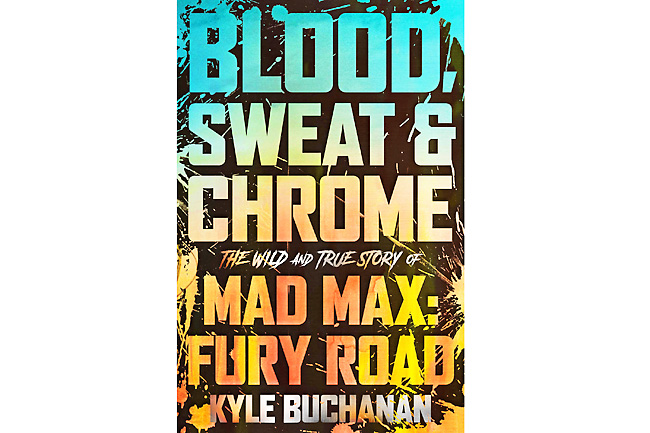Chris Klimek
THE WASHINGTON POST – The latter three films in the loosely connected Mad Max saga are set in a bleak future when the oral tradition is dominant and more advanced forms of record-keeping have, like every other comfort of civilisation, been blasted into dust.
So it’s fitting that the most comprehensive look yet into the franchise’s crowning achievement – 2015’s Mad Max: Fury Road – takes the form of an oral history. Juiced up from reporter Kyle Buchanan’s 4,600-word 2020 New York Times feature, Blood, Sweat & Chrome offers a candid, sometimes contradictory, always compelling examination of the most unlikely big-budget cinematic triumph since Titanic.
Assembled from more than 130 interviews with Fury Road’s makers and notable admirers, Buchanan’s book is a chronicle of near-miraculous creative, diplomatic and financial perseverance on the part of co-writer/producer/director George Miller, whom Buchanan dubs ‘The Visionary’ in his dramatis personae.
The story begins long before and continues long after the movie’s grueling 2012 location shoot in the southwest African nation of Namibia. The Thunderdome that Fury Road navigated on its way to the Academy Awards and cinephile Valhalla was not made up merely of such familiar blockbuster stumbling blocks as swollen budgets and tender egos, but by actual wars, natural disasters and palace intrigue at the studio covering its payroll.
Miller was an emergency physician before he pivoted into filmmaking with the three initial Mad Max entries circa 1979-1985, making an international star of young Mel Gibson in the process. From there, his eclectic filmography swerved from the frantic adaptation of John Updike’s The Witches of Eastwick to the somber medical drama Lorenzo’s Oil to the children’s film franchises Babe and Happy Feet.

By the mid-1990s, Miller was mulling a proposal to turn Mad Max into a syndicated TV series.
But a 1995 brainstorm set him to dreaming instead about the most frenetic and formally daring Max feature yet: a feature-length chase wherein the objects of pursuit would be five young women who had escaped enslavement. (As in the equally grim dystopia of The Handmaid’s Tale – a novel published the year Mad Max Beyond Thunderdome hit theatres – their fertility would doom them to servitude.) Exposition? Banned. Miller asked himself: “Can you tell an entire story on the run, and how much of the backstory can you pick up on the way?”
Miller recruited co-writer Eric Blakeney, comic book artist Brendan McCarthy and illustrator Peter Pound as collaborators, and the brain trust got to work immediately, creating a 3,500-panel storyboard in place of a traditional screenplay. (The film’s designers, several of whom would win Oscars for Fury Road, loved this approach; the actors, not so much.) Ideas flowed freely. And yet it would take two decades for Fury Road to reach cinemas.
Buchanan’s vivid account of the project reads like an auteur filmmaker’s version of the Book of Job. The USD104 million Fury Road 20th Century Fox had agreed to bankroll with a peak-stardom Gibson returning as Max was set to begin shooting in 2003, but the American-led invasion of Iraq that spring depressed the value of the US dollar against the Australian dollar, creating a budget gap that made Fox pull the plug.
Gibson’s advancing age and public self-immolation led Miller to replace him with a not-yet-famous Tom Hardy before preproduction ramped up again in 2010 in Broken Hill, Australia, where the filmmaker had shot The Road Warrior 30 years earlier. Then a freak superstorm turned the barren location Miller had chosen to reprise its role as The Wasteland into a veritable Eden, bursting with flowers and greenery not seen in decades. Hardy went off to play the heavy in The Dark Knight Rises while Miller and Warner Bros (which had picked up the project from Fox) waited for Broken Hill to turn barren again. It didn’t.
Finally, in 2012, producer Doug Mitchell leased a container ship for USD2 million, loaded it with the 120 custom vehicles the production had built, and set sail for Namibia, a location he’d scouted a decade earlier. According to executive producer Chris DeFaria, Mitchell didn’t tell the studio – which had decreed that shooting in Africa would be too risky – until the boat had left port.
On location in what may be the world’s oldest desert, top-billed actors Hardy and Charlize Theron struggled to give Miller what he wanted, in large part because of his habit of rolling film in bursts of a few seconds at a time. In Hardy’s summation, Miller “was trying to explain to us a colour we hadn’t seen yet”. (Margaret Sixel, Fury Road’s editor and Miller’s spouse, would win an Oscar for her work on the film.)
In the years since he’d been cast as Max, Hardy’s star had risen, and his erratic, waiting-for-inspiration-to-come method did not endear him to the punctual and disciplined Theron. (She’s candid here about her admiration for Miller, her frustration at the shoot’s chaotic workflow, and her disgust at producer Mitchell’s indulgence of Hardy’s tardiness and fits of temper.) Still more conflict came from the movie’s off-screen nemesis, Warner Bros President Jeff Robinov. After months of delays and cost overruns, Robinov forced Miller to wrap without having shot the movie’s ending – or its beginning! These scenes would be captured on soundstages in Sydney a year later, by which time Robinov had been fired. Hollywood can be as unforgiving as The Wasteland.
The forbidding environment, along with Miller’s insistence that Fury Road’s astonishing action beats be performed by non-digital, flesh-and-blood “stunties” atop real, full-size gas-guzzling vehicles, gave the picture a danger and verisimilitude that’s all but extinct from blockbusters in the Marvel era. Buchanan’s book will give even Fury Road’s most ardent admirers new reasons to celebrate Miller & Co’s singular achievement – and studio bean-counters new reasons to say no the next time a stubborn visionary asks them to cut a nine-figure check.





